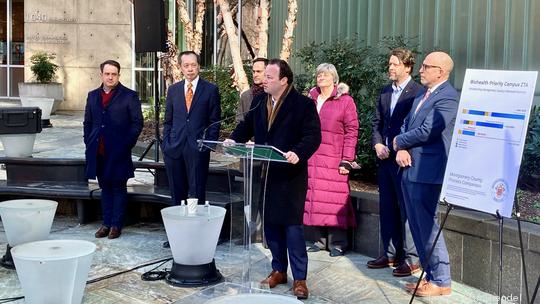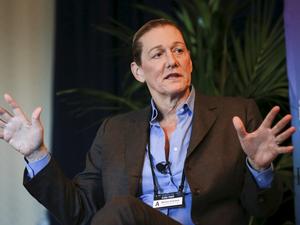
In a bid to keep and grow its flagship biohealth sector, Montgomery County is dramatically streamlining its regulatory review process for industry players who want to build or expand big lab facilities.
A new zoning text amendment, which the County Council unanimously approved Tuesday, will slash the lab entitlement process time from nearly two years to six months in an effort to “roll out the red carpet” for biotech industry leaders, said Councilman Andrew Friedson, D-District 1, who spearheaded the legislation.
“What will typically have taken 600 days can now take 160 days, a 75% reduction,” he said.
The new timelines would apply specifically to companies building at least 150,000 square feet of new space, or expanding existing space by at least 50,000 square feet, in certain areas, particularly near existing or planned rail and bus transit. That includes opportunity zones, which are areas designated for certain federal tax breaks in order to incentive private investment there. The changes are modeled after incentives the county designedearlier to try to land Amazon.com Inc.'s HQ2 campus, which ultimately went to Arlington.
“By green-taping the regulatory review process, biohealth leaders can focus their time and energies on what [they] should be focused on: their research,” Friedson said. "Not on unnecessary and more-than-needed regulatory processes."
We've reached out to his office about what potential trade-offs there may be as a result, and will update this story with its response. But a county planning department spokesperson said the focus on biohealth "may very well mean other projects will get delayed as we pull staff from those reviews.” The department “may need to request additional resources from the council,” the spokesperson said.
Several county movers and shakers applauded the fast-tracking measure for an industry that's been a lifeblood for the Interstate 270 corridor, further bolstered by the Covid pandemic's increased demand and federal funding opportunities for treatments and new vaccines. Though, at the same time, county leaders expressed cautionary notes about Montgomery County’s overall economic posture.
The new streamlining is "extremely important now because we have an economic crisis,” said Councilman Tom Hucker, D-District 5, citing the county’s recent loss of nearly 6,900 jobs. “We represent 38% of the job losses in the state of Maryland. … We're an outlier in the DMV region. We don’t have to be, and we shouldn’t be.”
Councilman Hans Riemer, D-At large, called for a “renaissance.” Targeting biohealth will build upon the presence of the National Institutes of Health, Food and Drug Administration, and National Institute of Standards and Technology, all located in Montgomery County, he said. He especially sees an “opportunity to really have a strong cluster” near the FDA’s campus in White Oak, he said at Tuesday’s council session.
“These are our Harvard, our MIT, our CalTech," Riemer said. "We may not have those kinds of universities here, but we have that kind of research power.”
Montgomery does include a Rockville campus for Johns Hopkins University, a research powerhouse that plans to expand that presence in the coming years, while the University of Maryland is next door in Prince George's County. Montgomery County Executive Marc Elrich has talked about the need to attract a larger research university presence to the county to anchor more economic growth, though doing so has its challenges.
“It’s really imperative that we continue to maintain the industry as an economic development priority,” said Ben Wu, president and CEO of the Montgomery County Economic Development Corp., noting that other municipalities are striving to attract the same biohealth companies, particularly in Northern Virginia.
Montgomery County faces a “supply problem” and needs another 2 million square feet of lab space “immediately” to maintain its competitive edge, he said, citing his organization’s 2021 “Connecting the Dots” report.
United Therapeutics Corp.’s (NASDAQ: UTHR) corporate real estate director, Thomas Kaufman, praised the zoning reform. His company, one of the region's largest drug developers with nearly $1.5 billion in revenue in 2020, plans to expand and is weighing its real estate opportunities in both Silver Spring, where it's headquartered, and North Carolina’s Research Triangle, though it isn’t ready to publicize specific plans, he said.



